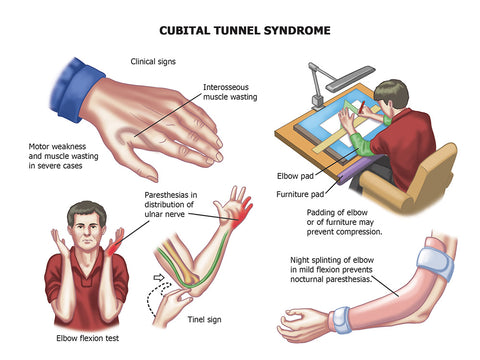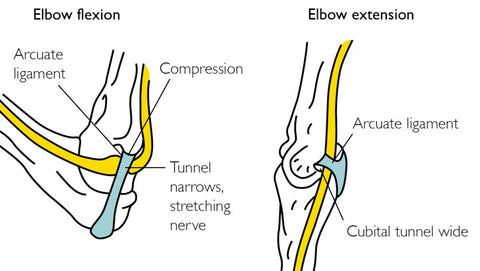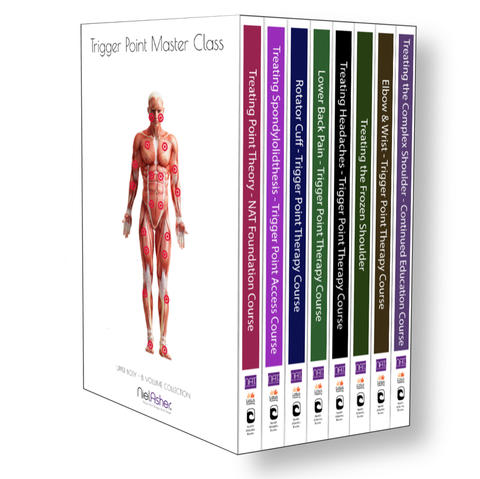Trigger Point Therapy - Cubital Tunnel Syndrome
Stuart Hinds - Treating Cubital Tunnel Syndrome
Cubital Tunnel Syndrome is the second most common peripheral nerve entrapment syndrome and is 5 times more common in men
Cubital Tunnel Syndrome (ulnar neuropathy) is a condition that is caused by compression to the ulnar nerve often by connective tissue or bone.
The ulnar nerve, one of the three main nerves in the arm, passes just under the skin’s surface close to the elbow or “funny bone”.
Any intense physical activity which adds pressure to this nerve can cause CTS, as can an abnormal bone growth in the elbow region.

What are the Symptoms of CTS?
In most cases, the pain develops slowly and gradually over weeks and months in the elbow area. It is less common for the symptoms to occur suddenly.
An aching pain or numbness may be felt in the inner elbow but most of the symptoms will be in the hand. The ring and little fingers may tingle too.
Some more severe symptoms may include:
• Difficulty coordinating fingers (e.g. if typing)
• Reduced ability to pinch the little finger and thumb together
• Wasting of hand muscles
• Reduction in gripping ability
• Finger numbness may wake some whilst sleeping
Who is Prone to CTS?
Anyone who participates in activities that require continuous periods of elbow flexion (e.g holding a telephone), especially when leaning against a hard surface, are more susceptible to this condition.
Baseball pitchers who repeatedly perform a twisting motion when throwing the ball have an increased risk of contracting CTS as this action can damage the elbow ligaments over time.
Obesity coupled with gripping something in a constant position whilst doing a repetitive action are considered major risk factors too.
Those who sleep with their arm bent under their pillow may also be more susceptible to CTS.
When the elbow is bent, the nerve shifts outwards from behind the medial epicondyle. If this happens repeatedly over time, it may cause irritation to the nerve.

Differential Diagnosis - What Else Could It Be?
Here is an incomplete list of other conditions which can mimic CTS:
• Trauma (fracture)
• Problems with the radial head of the radius bone at the elbow joint
• Injury to the ulnar nerve (radial tunnel syndrome)
• Problems with the discs in the neck C6/7 neuropathy (cervical disc)
• Dysfunction to the triangular articular cartilage disc at the wrist
• Osteoarthritis of the inner side of the elbow joint
• Ulnar collateral ligament injury
• Guvon’s canal syndrome (ulnar nerve compression syndrome)
• Golfer’s Elbow

Trigger Point Therapy
CTS is generally understood to be a condition that is caused by compression
to the ulnar nerve often by connective tissue or bone.
However, it may also be caused functionally with the development of active trigger points in the triceps, flexor carpi radialis and ulnaris muscles.
When a trigger point develops, the host muscle becomes shorter, thicker, and less efficient.
Because muscles are made up of 75% water and water does not compress well, they become functionally swollen, which often leads to a taut band that can have further pressure effects on local tissues.
Any change in shoulder, wrist, or elbow mechanics over time may manifest in areas of tight muscles where trigger points may develop.
Trigger point therapy in tandem with stretching and strengthening exercises can often be extremely effective in providing both short and long term relief from the symptoms of CTS.
Links
Find a Trigger Point Professional in your area
More Articles About Elbow Pain and Injuries
More Articles About Carpal Tunnel Syndrome
Articles About Tennis Elbow Treatment
Dry Needling for Trigger Points
Certify as a Trigger Point Therapist
About NAT Courses
As a manual therapist or exercise professional, there is only one way to expand your business - education!
Learning more skills increases the services that you offer and provides more opportunity for specialization.
Every NAT course is designed to build on what you already know, to empower you to treat more clients and grow your practice, with a minimal investment in time and money.
Help Desk
About Niel Asher Education
Niel Asher Education is a leading provider of distance learning and continued education courses.
Established in the United Kingdom in 1999, we provide course and distance learning material for therapists and other healthcare professionals in over 40 countries.
Our courses are accredited by over 90 professional associations and national accreditation institutions including the National Academy of Sports Medicine (NASM) and National Certification Board for Therapeutic Massage and Bodywork (NCBTMB). Full details of all international course accreditations can be found on our website.
Printed course materials and other products offered on our websites are despatched worldwide from our 3 locations in the UK (London), USA (Pennsylvania) and Australia (Melbourne).
More About Us
NAMTPT AWARD
We are honored to have received the 2017 "Excellence in Education" Award from the National Association of Myofascial Trigger Point Therapists.
Since 1999 Niel Asher Education has won numerous awards for education and in particular for education and services provided in the field of trigger point therapy.
Read Full Article
Award Winning Instructors
Niel Asher Healthcare course instructors have won a host of prestigious awards including 2 lifetime achievement honorees - Stuart Hinds, Lifetime Achievement Honoree, AAMT, 2015, and Dr. Jonathan Kuttner, MD, Lifetime Achievement Honoree, NAMTPT, 2014.
Meet the Instructors
Accreditation

If you are a qualified/licensed manual therapist or exercise/fitness professional you can expand your credentials with NAT certification.
In addition to national accreditation for continued education, each course that we offer includes "NAT Learning Credits". By taking and completing courses you can accumulate NAT credits to qualify for NAT certification.
There are currently 3 levels of NAT certification. Certifying NAT is a valuable way to show your clients that you take continued education seriously, and to promote your skills and qualifications.
Most of our courses are accredited for CE/CPD/CPE. A full list of CE accreditations can be found by clicking on the link below.
About NAT Certification
Niel Asher Technique
Since 1999 the Niel Asher Technique for treating trigger points has been adopted by over 100,000 therapists worldwide, and has been applied to the treatment of a number of common musculoskeletal injuries.
The Niel Asher Technique for treating frozen shoulder was first introduced and published in 1997 and has been widely adopted by therapists and exercise professionals working within elite sports and athletics.
Read More
International Students
Most of our courses are available as either "Printed" or 'Download" editions, wherever you live. Internet connection is required to access online and downloadable material.
When you purchase a download edition, you receive immediate lifetime access to all course material. Course texts can be downloaded and printed if required.
When you purchase a "Printed" edition, you will also receive free access to the download edition.
We ship Worldwide from locations in the USA, UK, and Australia. Most items are despatched within 24 hours and shipping is FREE for all orders over US$50.
Shipping
Where to Start?
We offer a range of over 50 courses, presented by some of the worlds leading manual therapists. All courses are reviewed annually, and new courses are regularly added.
Our courses are modular, and designed to build on what you already know. For more information, please visit our "Where to Start?" page.
Start Here
Trigger Point Therapy Master Course
About Niel Asher Education
Niel Asher Education (NAT Global Campus) is a globally recognised provider of high-quality professional learning for hands-on health and movement practitioners. Through an extensive catalogue of expert-led online courses, NAT delivers continuing education for massage therapists, supporting both newly qualified and highly experienced professionals with practical, clinically relevant training designed for real-world practice.
Beyond massage therapy, Niel Asher Education offers comprehensive continuing education for physical therapists, continuing education for athletic trainers, continuing education for chiropractors, and continuing education for rehabilitation professionals working across a wide range of clinical, sports, and wellness environments. Courses span manual therapy, movement, rehabilitation, pain management, integrative therapies, and practitioner self-care, with content presented by respected educators and clinicians from around the world.
Known for its high production values and practitioner-focused approach, Niel Asher Education emphasises clarity, practical application, and professional integrity. Its online learning model allows practitioners to study at their own pace while earning recognised certificates and maintaining ongoing professional development requirements, making continuing education accessible regardless of location or schedule.
Through partnerships with leading educational platforms and organisations worldwide, Niel Asher Education continues to expand access to trusted, high-quality continuing education for massage therapists, continuing education for physical therapists, continuing education for athletic trainers, continuing education for chiropractors, and continuing education for rehabilitation professionals, supporting lifelong learning and professional excellence across the global therapy community.

Continuing Professional Education
Looking for Massage Therapy CEUs, PT and ATC continuing education, chiropractic CE, or advanced manual therapy training? Explore our evidence-based online courses designed for hands-on professionals.



















